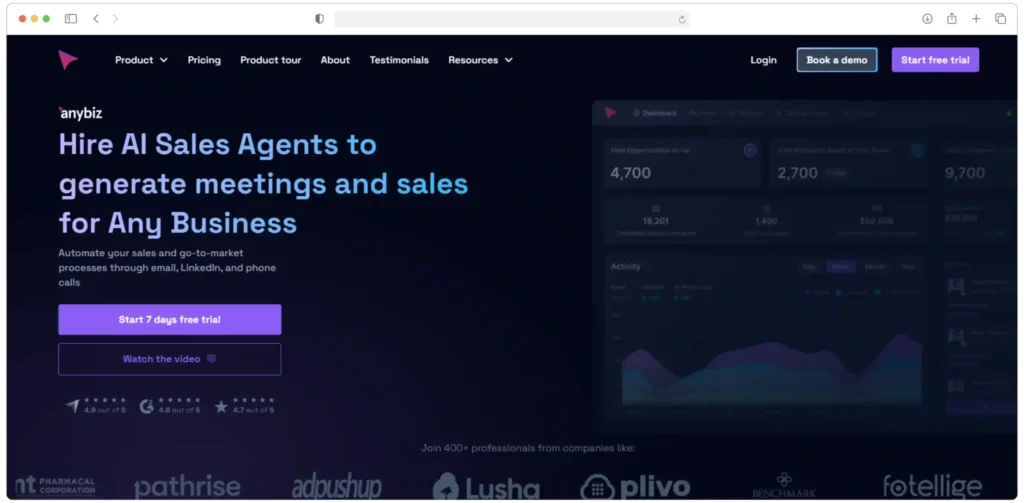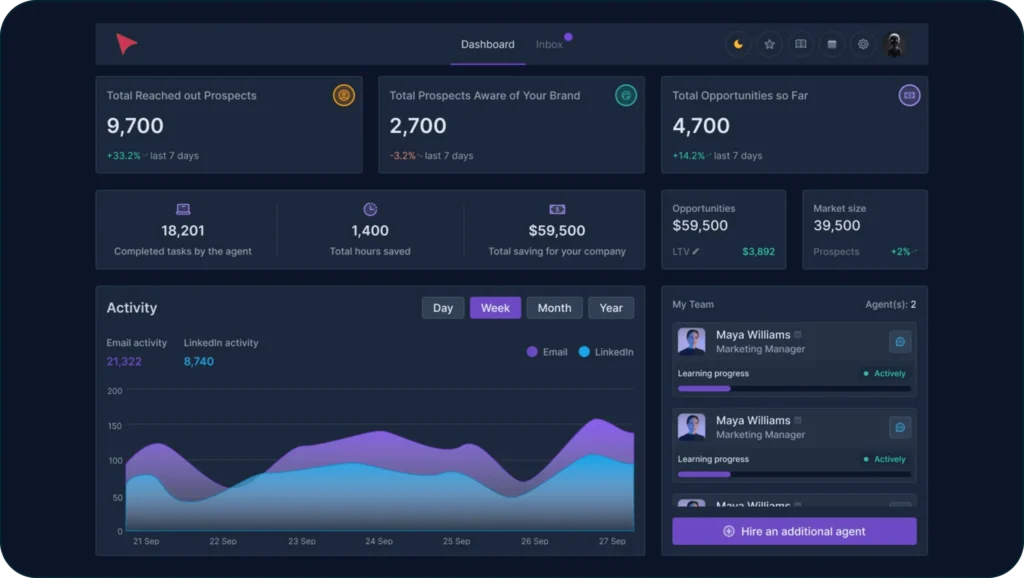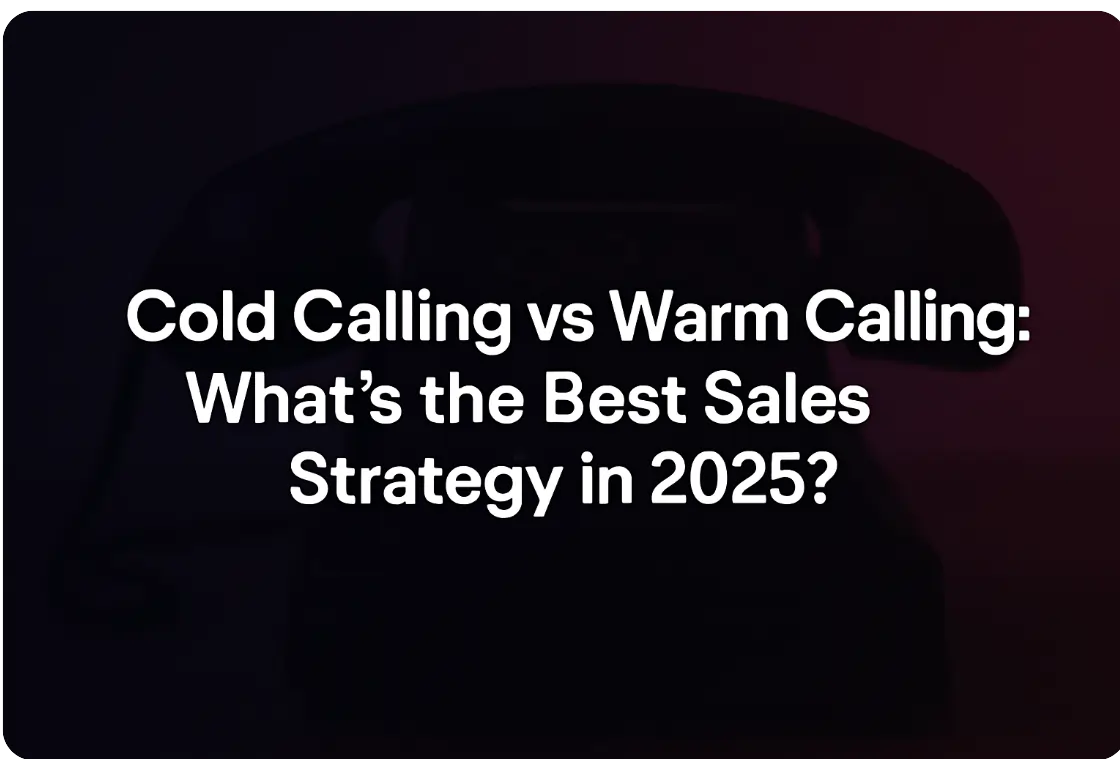We break down the pros, cons, and real-life examples of both techniques—plus when and how to use them together.
[Check Out Anybiz as Your Complete Outreach Strategy! ]
Spam filters, auto-blockers and instant “ignore” buttons are the common enemy of sales leaders in the B2B space when it comes to cold outreaching their product or service.
But perhaps one of the most challenging aspects that ails many sales leaders is understanding the ideal channel to reach the ideal prospect.
For decades, cold calling has been the go-to of many sales professionals, but with the unceasing changes in buyer behavior, ethics in data privacy regulation, and development of AI sales agents, warm calling snuck its way as a more personalized alternative.
But what is warm calling? And which one can generate a better conversion rate?
This blog post will answer exactly that and the following:
- Understand the difference between cold calling vs warm calling
- When to use each technique — vis-a-vis, the right calling approach.
- Types of calls to generate leads and achieve higher success rates.
- Tools and calling tips to improve results; including the proper sales approach
- Real-world workflows that combine both strategies to achieve better results
What Is Cold Calling?
Cold calling is a sales technique that reaches out to potential customers that have no prior contact with your company — no relationship, no warm introduction, and no expectation of your call. It is a method that generates an ideal conversion rate, which makes it a mainstream marketing tactic for salesperson and sales rep.
Characteristics of Cold Calling
As a classic outbound sales strategy, it is often the first step in initiating contact; a useful technique when targeting new customers or building a fresh pipeline. However, it can be challenging and without proper consideration of its ethical practices, it can be harmful for your sales success.
Despite these challenges, notwithstanding, cold calling remains an important channel in terms of lead generations — as long as it is well-planned.
Key characteristics of cold calling include:
- No previous engagement or interaction: The prospect has not shown prior interest or been in touch with your company before the call.
- High-volume strategy: Success is typically driven by numbers—more calls mean more chances of finding the right prospects.
- Focused on lead generation and pipeline building: Cold calls are primarily used to spark interest and move leads into your sales funnel.
Best Used For:
Cold calling is not just about dialling random numbers, by integrating proper tactics cold calling can be your best outreach strategy it is best used for:
- Prospecting new verticals: Perfect for identifying or exploring other avenues and industries that you haven’t sold to before.
- Expanding into untapped markets: Develop conversations in regions or sectors where your brand may need further awareness.
- Top-of-funnel outreach: Ideal for initiating interest and moving prospects into your lead nurturing sequences.
- Testing new buyer personas or segments: Enable real-time feedback on messaging and offers tailored to emerging customer profiles.
Tips to Improve Cold Calling Success:
Use AI powered tools such as Anybiz
As a company dedicated to improving your outreach strategies, we understand that AI cold calling is significantly more effective than its traditional counterpart. But with tons of AI sales tools in the market, it can be difficult to choose the best one to fit your AI cold calling strategies.
Anybiz is proven to be one of the top AI sales tools that can supercharge your prospecting, it operates under the most advanced machine learning algorithm and Large Language Model (LLM) allowing it to intelligently respond to your prospect during cold calling outreach.

However, Anybiz is not just limited to cold calling, the AI sales agent is also capable of multichannel engagement that spans from email and LinkedIn.
But how does it work?
Anybiz has an exclusive database of 400 million prospects. Using this database, that AI agent can effectively target prospects and eventually perform outreach activities depending on their engagement level.
Apply Hyper-Personalized and the Best Opening Lines
Utilizing AI sales tools provides significant advantages in your cold calling pursuit, but it can be too generic, or worse, robotic. Employing personalization and incorporating a template for your opening line can help capture attention, thus improving your success rate.
Messaging Tab
Choose the type of message you want to send—whether it’s an email introduction, follow-up, LinkedIn message, or AI cold call. This allows you to tailor your communication based on where the prospect stands in the sales process.
Language Tab
Anybiz provides one of the most powerful advantages of ensuring engagement and clarity for your prospects and that is selecting the language that your prospects would be most comfortable with.
You can choose the language your AI Agent from the email outreach to AI cold calls, such as
- English
- Spanish
- French
- German
- Italian
- Romanian
- Ukrainian, and many more.
Tone of Voice
Selecting the right tone is essential for building strong client relationships. You can choose from formal, professional, friendly, or conversational.
Use Pattern Interrupts to Grab Attention
One of the patterns that we’ve noticed when it comes to outreaching is there is a low chance that your prospects may ignore your sales pitch, or let alone pick up the phone.
So what exactly can you do to break through this probability?
The answer is incorporating pattern interruption, or in layman’s term — the element of surprise.
To be outstanding in your outreaching, then you just need to stand out, and although it does not save you from any sales objection, it can increase your generated leads. However, we understand that this is easier said than done, hence using pattern interrupt technology can increase your chance of generating an engagement. Here is how:
- Surprise your prospect, but ensure that you maintain a comfortable interaction
Using terms such as “Hey [Name of Prospect], Thank you for picking up! How are you doing today? I hope I have called you at the best possible time?”
Lines like these usually are generic but are a great conversation starter. It acknowledges your prospect’s time, and it ensures that you are not immediately rejected by asking something irrelevant from your sales pitch such as “How are you today?”, and instead making them comfortable.
- Use Timeline, Stresses and Intonation to Emphasize your Sales Pitch
Once you get them hooked, and they express that they can stay on the phone, start with the advantages that they can get if they listen to you.
First, you need to establish a timeline.
The most ideal length of cold calling should span between 20 seconds and 60 seconds. Now this is not a promise, if everything goes well then it can be longer, but remember to emphasize the term “seconds.”
If you are cold calling someone, always presume that they are in a hurry, hence they cannot stay on the phone for longer. Stressing that you can talk to them in a manner of seconds program their brain into thinking that it can be a short call. So instead of saying, “Can we talk for 1 minute?” replace it with “Can you give me 60 seconds of your time?”
Then stress the positive adjectives, then lower your intonation in the more negative ones.
Incorporating these two you can generate a pattern interrupted template like this:
“Hey [Prospect Name], I know this call is out of the blue — mind if I take 27 seconds to explain why I’m calling, and then you can decide if we continue?”
If they say “Sure,” continue with:
“I work with [similar companies/roles] helping them [specific benefit or result]. I thought you might find it relevant too — would that be worth chatting about briefly?”
Track call activity and follow up via multichannel (email, LinkedIn)
Anybiz offers an exclusive AI dashboard that can help you monitor your AI agent’s activities, including Call Activity for tracking call outcomes, whether your calls are getting ignored, or have been responded to.

Monitoring the progress of the AI agent’s activities are crucial for establishing and understanding if it is generating any ROI (Return on Investment), giving you the ability to have a complete overview of engagement and outreach activities performed by the AI agent across:
- Emails (viewing the total numbers of emails sent)
- Call activities (ignored and responded calls)
- LinkedIn (connection request, messages sent, and profile views)
Now that we’ve established the meaning of cold calling, we should now explore what’s the difference between cold calling and warm calling.
What Is Warm Calling?
Warm calling — or hot call —is another outreach strategy that interacts with leads that has prior contact with your company.
This can either be an indirect previous interaction such as reading your post on Linkedin, referrals from their colleague or friends; or a more direct interaction such as opening an email, or filling out a form
The key difference between warm calling and cold calling is their level of awareness or interest for your product or service.
Characteristics of Warm Calling
Unlike cold calling, warm calling offers a higher conversion rate since it is contacting a prospect that has prior knowledge, engagement, interaction and interest in your product. Here is a deeper dive of its characteristics.
Prior Contact or Interest:
Occurs after a prior interaction, whether it’s through email, LinkedIn, a webinar, or a referral. The prospect has already shown some interest, so they’re not a complete stranger. This context makes them more open to conversation.
Higher Response and Conversion Rates:
Because the prospect is familiar with you or your company, warm calling generally leads to higher engagement. The chances of a response or conversion are significantly better than cold calling, as the prospect is already somewhat interested in what you have to offer.
Requires Lead Intelligence and Tracking:
Warm calling is based on solid lead intelligence. Knowing how and when to reach out, what interests them, and why they might be a good fit is essential. Effective use of CRM tools and lead tracking ensures you have all the necessary information to personalize the call and speak to the prospect’s pain points.
Lower Volume, But More Targeted and Effective:
Involves fewer calls but with greater impact. Since you are calling prospects who have already shown interest or are part of your pipeline, the effort is concentrated on high-value targets, making each call more meaningful and impactful. This method avoids the “spray and pray” approach of cold calling, focusing efforts on warmer leads that have a higher chance of converting.
Best Used For:
- Following up on marketing qualified leads (MQLs)
- Booking demos or discovery calls
- Nurturing inbound leads
- Re-engaging old prospects or dormant accounts
Anybiz as a Warm Calling Tool
You can use Anybiz as your warm and cold outreach system thanks to its large prospect database of 400 million. Warm calling requires leads who have already interacted with your service, and using its multichannel engagement capabilities of email, LinkedIn and AI cold calls, it makes sales prospecting and warm calling easier.
Here is how it usually works.
Email Outreach (Preparing for Preliminary Interaction)
To ensure that the leads are warm the AI agent will use email as a preliminary channel. This will involve initial contact, and then a follow-up. After this, a segmentation process will occur classifying your prospect’s engagement level, behavior and characteristics.
Note: To increase the engagement level the AI agent will include a personalized landing page that displays your business and highlights your unique selling proposition — an advantage that will not require any human intervention when it comes to its design.
LinkedIn Outreach (Brand Awareness)
Our system can integrate with your LinkedIn and use it to establish brand awareness and network connection. It can send a connection request, follow-up messages and monitor other activities, such as LinkedIn views and message responses to better cater your strategies.
AI Cold Call Outreach (Preparing for Warm Calls)
Once it is confirmed that the prospect is well-aware of your product, an AI cold call will ensue. It can then schedule sales calls for your warm lead giving you a chance to provide your unique selling proposition which can ultimately lead to sales.
When to Use Each One
Use Cold Calling When:
- Entering a new market or vertical
- Running an outbound sprint or campaign
- Building your initial prospect list
- Validating a new offer or messaging angle
Example: You’re launching a new feature for HR software and want to test the message with mid-sized companies in a new region.
Use Warm Calling When:
- A prospect opened your email (but didn’t reply)
- Someone downloaded your lead magnet or attended a webinar
- You recently connected on LinkedIn
- A prospect showed intent but didn’t book a meeting
Example: A CMO downloaded your 2025 marketing trends guide last week. Now’s the time to call and check in.
Can You Combine Cold + Warm Calling?
Absolutely—and you should.
The most effective outreach strategies today involve multichannel workflows that use a blend of cold and warm techniques.
Example Workflow 1:
Cold email → LinkedIn connect → Warm call
- Send a personalized cold email
- Connect on LinkedIn with a note
- After they accept, place a warm call referencing both
Example Workflow 2:
Cold call → Voicemail → Follow-up email → Warm call
- Place cold call and leave a short voicemail
- Immediately follow up with an email or LinkedIn message
- Call back 2–3 days later referencing the message—now it’s warm
Multichannel Outreach Tools:
- Warmy.io: For domain warming, contributing to your email deliverability.
- Anybiz: Uses AI agents to manage outreach, track replies, and optimize workflows automatically.
By combining cold and warm strategies, you:
- Increase brand awareness over time
- Get multiple touches on each lead
- Build trust through consistency
Cold Calling vs Warm Calling—Which One Wins?
The truth? There’s no one-size-fits-all strategy. It is not warm calling vs cold calling, but cold calling and warm calling to improve your sales process.
In 2025, cold calling still works—especially for breaking into new accounts. But warm calling converts better, thanks to existing engagement.
The best sales teams use both:
- Cold calling to start conversations.
- Warm calling to continue and close them.
Want to modernize your outreach strategy? Book a Demo with Anybiz to automate cold + warm calls at scale using AI, or try it for very little cost.


